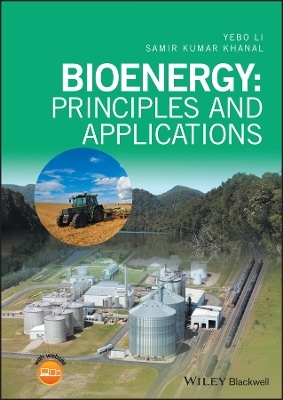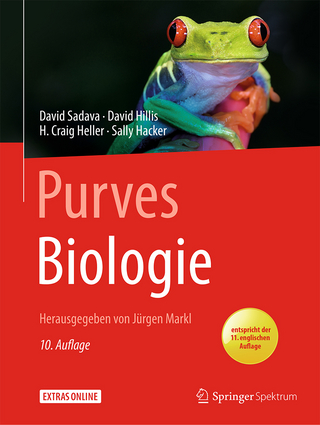
Bioenergy
John Wiley & Sons (Verlag)
978-1-118-56831-6 (ISBN)
Yebo Li is an Assitant Professor in the Department of Food, Agricultural, and Biological Engineering and Director of the Bioproducts and Bioengineering Laboratory at the Ohio State University. Samir Kumar Khanal, PhD, P.E. is an Associate Professor of Bioengineering in the Bioenergy Research Group?in the Department of Molecular Biosciences and Bioengineering at the University of Hawaii-Manoa.
LIST OF CONTRIBUTORS
PREFACE
ACKNOWLEDGMENTS
ABOUT THE COMPANION WEBSITE
SECTION I BIOENERGY FUNDAMENTALS
1 INTRODUCTION TO BIOENERGY
Samir Kumar Khanal and Yebo Li
1.1 Energy
1.2 Non-renewable Energy
1.3 Renewable Energy
1.4 Why Renewable Energy?
1.4.1 Energy Insecurity
1.4.2 Depletion of Energy Resources Reserves
1.4.3 Concern about Climate Change
1.5 Bioenerg
1.5.1 Current Status of Bioenergy Production
1.5.2 Merits of Bioenergy
1.5.3 Demerits of Bioenergy
References
Exercise Problems
2 UNITS AND CONVERSIONS
Samir Kumar Khanal
2.1 Introduction
2.2 Units of Measurement
2.3 Useful Units and Conversions
2.4 Energy and Heat
2.4.1 Power
2.4.2 Heating Value
2.4.3 Heat Capacity
2.5 Volume–Mass Relationship
2.6 Ideal Gas Law
2.7 Henry’s Law
References and Further Reading
Exercise Problems
3 MASS AND ENERGY BALANCES
Devin Takara and Samir Kumar Khanal
3.1 Introduction
3.2 Mass Balances
3.3 Enthalpy
3.4 Energy Balances
References and Further Reading
Exercise Problems
4 THERMODYNAMICS AND KINETICS OF BASIC CHEMICAL REACTIONS
Devin Takara and Samir Kumar Khanal
4.1 Introduction
4.2 Reaction Thermodynamics
4.3 Reaction Kinetics
References and Further Reading
Exercise Problems
5 ORGANIC AND CARBOHYDRATE CHEMISTRY
Xiaolan Luo and Yebo Li
5.1 Introduction
5.2 Structural Formulas and Classification of Organic Compounds
5.3 Aliphatic Compounds
5.3.1 Alkanes and Cycloalkanes
5.3.2 Alkenes and Alkynes
5.3.3 Alcohols and Ethers
5.3.4 Aldehydes and Ketones
5.3.5 Carboxylic Acids and Derivatives
5.3.6 Other Aliphatic Compounds
5.4 Aromatic Compounds
5.5 Heterocyclic Compounds
5.6 Carbohydrates
5.6.1 Monosaccharides
5.6.2 Oligosaccharides
5.6.3 Polysaccharides
5.7 Proteins and Lipids
5.7.1 Proteins
5.7.2 Lipids
References and Further Reading
Exercise Problem
6 PLANT STRUCTURAL CHEMISTRY
Samir Kumar Khanal, Saoharit Nitayavardhana, and Rakshit Devappa
6.1 Introduction
6.2 Carbohydrates and Their Classification
6.2.1 Monosaccharides
6.2.2 Oligosaccharides
6.2.3 Polysaccharides
6.3 Main Constituents of Plant Biomass
6.3.1 Structural Carbohydrates
6.3.2 Lignin
6.4 Plant Cell Wall Architecture
6.4.1 Primary Cell Wall
6.4.2 Secondary Cell Wall
References
Exercise Problems
7 MICROBIAL METABOLISMS
Arul M. Varman, Lian He, and Yinjie J. Tang
7.1 Introduction
7.2 Carbon Metabolisms
7.3 Metabolic Models
7.3.1 Microbial Growth in Batch Culture
7.3.2 Monod Equation for Microbial Growth
7.3.3 Inhibition and Multiple Substrate Models
7.3.4 Monod-Based Kinetic Model in Batch Bioreactors
7.3.5 Monod Model Coupled with Mass Transfer
7.3.6 Mass Balances and Reactions in Fed-Batch and Continuous-Stirred Tank Bioreactors
7.3.7 Elemental Balance and Stoichiometric Models
References
Exercise Problems
Appendix 7.1 Code Useful for Example 7.2
SECTION II BIOENERGY FEEDSTOCKS
8 STARCH-BASED FEEDSTOCKS
Xumeng Ge and Yebo Li
8.1 Introduction
8.2 Corn
8.2.1 Growth and Development of Corn
8.2.2 Growing Degree Days for Corn Growth
8.2.3 Cultivation Practices in Corn Production
8.2.4 Harvesting and Storage of Corn
8.3 Sweet Potato
8.3.1 Growth and Development of Sweet Potato
8.3.2 Cultivation Practices in Sweet Potato Production
8.3.3 Harvesting and Storage of Sweet Potato
8.4 Cassava
8.4.1 Growth and Development of Cassava
8.4.2 Cultivation Practices in Cassava Production
8.4.3 Harvesting and Storage of Cassava
8.5 Comparison of Composition, Yield, and Energy Potential of Corn, Sweet Potato, and Cassava
References
Exercise Problems
9 OILSEED-BASED FEEDSTOCKS
Chengci Chen and Marisol Berti
9.1 Introduction
9.2 Soybean
9.2.1 Feedstock Production and Handling
9.2.2 Nutrient and Water Use
9.3 Rapeseed and Canola
9.3.1 Feedstock Production and Handling
9.3.2 Nutrient and Wate
9.5.1 Feedstock Production and Handling
9.5.2 Nutrient and Water Use
9.6 Camelina
9.6.1 Feedstock Production and Handling
9.6.2 Nutrient and Water Use
9.7 Yield and Oil Content of Major Oilseed Feedstocks
References
Exercise Problems
10 LIGNOCELLULOSE-BASED FEEDSTOCKS
Sudhagar Mani
10.1 Introduction
10.2 Feedstock Availability and Production
10.2.1 Crop Residues
10.2.2 Dedicated Energy Crops
10.2.3 Forest Biomass
10.3 Feedstock Logistics
10.3.1 Harvesting and Collection of Crop Residues and Energy Crops
10.3.2 Harvesting of Forest Biomass
10.3.3 Transportation
10.3.4 Storage
References
Exercise Problems
11 ALGAE-BASED FEEDSTOCKS
Xumeng Ge, Johnathon P. Sheets, Yebo Li, and Sudhagar Mani
11.1 Introduction
11.2 Algae Classification, Cell Structure, and Characteristics
11.3 Mechanism of Algal Growth
11.4 Algal Growth Conditions
11.4.1 Light
11.4.2 CO2 Concentration
11.4.3 Temperature, pH, and Salinity
11.4.4 Nutrients
11.5 Steps in Algal-Biodiesel Production
11.5.1 Algal Cultivation
11.5.2 Harvesting
11.5.3 Drying
11.5.4 Lipid Extraction
References
Exercise Problems
SECTION III BIOLOGICAL CONVERSION TECHNOLOGIES
12 PRETREATMENT OF LIGNOCELLULOSIC FEEDSTOCKS
Chang Geun Yoo and Xuejun Pan
12.1 Introduction
12.2 What Does Pretreatment Do?
12.3 Physical Pretreatment
12.4 Thermochemical Pretreatment
12.4.1 Acid Pretreatment
12.4.2 Alkaline Pretreatment
12.4.3 Organosolv Pretreatment
12.4.4 Sulfite-Based Pretreatment
12.4.5 The Combined Severity (CS) Factor
12.5 Other Pretreatments
12.5.1 Cellulose Solvent-Based Pretreatment
12.5.2 Biological Pretreatment
12.5.3 Ultrasonic Pretreatment
12.5.4 Microwave Pretreatment
12.6 Co-products from Lignocellulosic Feedstock Pretreatment
12.6.1 Hemicellulosic Sugars
12.6.2 Furans (Furfural and HMF)
12.6.3 Lignin
References
Exercise Problems
13 ENZYMATIC HYDROLYSIS
David Hodge and Wei Liao
13.1 Introduction
13.2 Nomenclature and Classification of Hydrolases
13.3 Enzyme Kinetics
13.3.1 Fundamentals of Reaction Rate: Transition State Theory
13.3.2 Reaction Rate and Reaction Orders
13.3.3 Michaelis–Menten Kinetics
13.3.4 Enzyme Inhibition
13.4 Enzymatic Hydrolysis of Carbohydrates
13.4.1 Carbohydrate Structure
13.4.2 Starch Depolymerization
13.4.3 Cellulose Hydrolysis
13.4.4 Hemicellulose Hydrolysis
13.4.5 Key Factors Affecting the Enzymatic Hydrolysis of Lignocellulosic Feedstocks
References
Exercise Problems
14 ETHANOL FERMENTATION
Saoharit Nitayavardhana and Samir Kumar Khanal
14.1 Introduction
14.2 Biochemical Pathway
14.2.1 Hexose Fermentation
14.2.2 Pentose Fermentation
14.3 Byproducts Formation during Ethanol Fermentation
14.4 Microbial Cultures
14.4.1 Yeast Culture for Hexose Fermentation
14.4.2 Microbial Culture for Pentose Fermentation
14.5 Environmental Factors Affecting Ethanol Fermentation
14.5.1 Nutrients
14.5.2 pH
14.5.3 Temperature
14.5.4 Others
14.6 Industrial Fuel-Grade Ethanol Production
14.6.1 Seed Culture Preparation
14.6.2 Industrial Ethanol Fermentation
14.6.3 Ethanol Recovery
References
Exercise Problems
15 BUTANOL FERMENTATION
Victor Ujor and Thaddeus Chukwuemeka Ezeji
15.1 Introduction
15.2 Butanol Fermentation
15.2.1 Acetone-Butanol-Ethanol (ABE) Fermentation
15.2.2 Biochemical Pathway
15.2.3 Stoichiometry and Product Yield
15.2.4 Microbiology
15.3 Factors Affecting Butanol Fermentation
15.3.1 pH
15.3.2 Availability of Co-factors (NADH)
15.3.3 Medium Composition
15.3.4 Product Inhibition
15.4 Substrates for Butanol Fermentation
15.5 Advanced Butanol Fermentation Techniques and Downstream Processing
15.5.1 Gas Stripping
15.5.2 Vacuum Fermentation
15.5.3 Liquid–Liquid Extraction
15.5.4 Pervaporation
References
Exercise Problems
16 SYNGAS FERMENTATION
Mark R. Wilkins, Hasan K. Atiyeh, and Samir Kumar Khanal
16.1 Introduction
16.2 Stoichiometry
16.3 Syngas-Fermenting Bacteria
16.3.1 Biochemical Pathway
16.3.2 Genetic Transformation of Syngas-Fermenting Bacteria
16.3.3 Microbial Kinetics
16.4 Factors Affecting Syngas Fermentation
16.4.1 Medium Composition
16.4.2 pH
16.4.3 Temperature
16.4.4 Mass Transfer
16.4.5 Bioreactor Configurations
16.5 Product Recovery
References
Exercise Problems
17 FUNDAMENTALS OF ANAEROBIC DIGESTION
Samir Kumar Khanal and Yebo Li
17.1 Introduction
17.2 Organic Conversion in an Anaerobic Process
17.3 Stoichiometry of Methane Production
17.4 Important Considerations in Anaerobic Digestion
17.4.1 Temperature
17.4.2 pH and Alkalinity
17.4.3 Nutrients
17.4.4 Toxic Materials and Inhibition
17.4.5 Total Solids Content
17.4.6 Volumetric Organic Loading Rate (VOLR)
17.4.7 Hydraulic Retention Time (HRT) and Solids Retention Time (SRT)
17.4.8 Start-up
17.5 Anaerobic Digestion Model No. 1 (ADM1)
References
Exercise Problems
18 BIOGAS PRODUCTION AND APPLICATIONS, 338
Samir Kumar Khanal and Yebo Li
18.1 Introduction
18.2 Anaerobic Digestion Systems
18.2.1 Suspended Growth System
18.2.2 Attached Growth System
18.2.3 Solid-State Anaerobic Digestion System
18.2.4 Household Digester
18.3 Biogas Cleaning and Upgrading
18.3.1 Physical Methods
18.3.2 Chemical Methods
18.3.3 Biological Methods
18.4 Biogas Utilization
18.5 Digestate
References
Exercise Problems
19 MICROBIAL FUEL CELLS
Hongjian Lin, Hong Liu, Jun Zhu, and Venkataramana Gadhamshetty
19.1 Introduction
19.2 How Does a Microbial Fuel Cell (MFC) Work?
19.3 Electron Transfer Processes
19.3.1 Mediated Electron Transfer
19.3.2 Direct Electron Transfer (DET)
19.3.3 Bacterial Nanowires
19.3.4 Long-Range Extracellular Electron Transfer
19.4 Electrical Power and Energy Generation
19.4.1 Redox Reaction and Electrode Potential
19.4.2 Electromotive Force and Cell Potential
19.4.3 Electrical Power
19.4.4 Coulombic and Energy Efficiency
19.5 Design and Operation of an MFC
19.5.1 MFC Configurations
19.5.2 Separators
19.5.3 Anode Materials and Catalysts
19.5.4 Cathode Materials and Catalysts
19.5.5 Substrates
References
Exercise Problems
SECTION IV THERMAL CONVERSION TECHNOLOGIES
20 COMBUSTION FOR HEAT AND POWER
Sushil Adhikari, Avanti Kulkarni, and Nourredine Abdoulmoumine
20.1 Introduction
20.2 Fundamentals of Biomass Combustion
20.2.1 Biomass Combustion Phases
20.2.2 Biomass Combustion Reaction and Stoichiometry
20.3 Biomass Properties and Preprocessing
20.3.1 Biomass Properties
20.3.2 Biomass Preprocessing
20.4 Biomass Furnaces
20.4.1 Fixed-Bed Furnaces
20.4.2 Fluidized-Bed Furnaces
20.5 Power Generation
20.5.1 Carnot Cycle
20.5.2 Rankine Cycle
20.5.3 The Air-Standard Brayton Cycle
20.5.4 Combined Gas Turbine and Steam Turbine Power Cycles
20.6 Biomass Co-firing with Coal
20.7 Environmental Impact and Emissions of Biomass Combustion
References
Exercise Problems
21 GASIFICATION
Sushil Adhikari and Nourredine Abdoulmoumine
21.1 Introduction
21.2 Fundamentals of Gasification
21.2.1 Gasifying Agents
21.2.2 Gasification Reactions
21.3 Gasifiers
21.3.1 Moving-Bed Gasifiers
21.3.2 Fluidized-Bed Gasifiers
21.3.3 Entrained-Flow Gasifiers
21.4 Feedstock Preparation and Characterization
21.4.1 Feedstock Preparation
21.4.2 Feedstock Characterization
21.5 Gasification Mass and Energy Balance
21.5.1 Mass Balance
21.5.2 Energy Balance
21.6 Gas Cleanup
21.7 Applications of Biomass Gasification
References
Exercise Problems
Appendix
22 PYROLYSIS
Manuel Garcia-Perez
22.1 Introduction
22.2 Slow vs. Fast Pyrolysis
22.2.1 Slow Pyrolysis
22.2.2 Fast Pyrolysis
22.3 Pyrolysis Reactions and Mechanisms
22.3.1 Pyrolysis Reactions
22.3.2 Reaction Mechanisms
22.4 Single-Particle Models
22.5 Bio-Oil
22.6 Charcoal
22.7 Bio-oil Refining
References
Exercise Problems
SECTION V BIOBASED REFINERY
23 SUGAR-BASED BIOREFINERY
Samir Kumar Khanal and Saoharit Nitayavardhana
23.1 Introduction
23.2 Stoichiometry
23.3 Sugarcane Ethanol
23.3.1 Ethanol Production Process
23.3.2 Sugarcane-to-Ethanol Biorefinery
23.4 Sweet Sorghum Ethanol
23.5 Sugar Beet Ethanol
23.6 Biochemicals and Biopolymers
23.6.1 Lactic Acid
23.6.2 Succinic Acid
23.6.3 1,3-Propanediol
23.6.4 3-Hydroxypropionic Acid
References
Exercise Problems
24 STARCH-BASED BIOREFINERY
Samir Kumar Khanal and Saoharit Nitayavardhana
24.1 Introduction
24.2 Stoichiometry of Starch to Ethanol
24.2.1 Corn-Based Ethanol Biorefinery
24.2.2 Corn-to-Ethanol Plants and Sorghum-to-Ethanol Plants
24.2.3 Cassava-Based Ethanol Biorefinery
24.3 Integrated Farm-Scale Biorefinery
References
Exercise Problems
25 LIGNOCELLULOSE-BASED BIOREFINERY
Scott C. Geleynse, Michael Paice, and Xiao Zhang
25.1 Introduction
25.2 Cell Structure of Lignocellulosic Feedstocks
25.3 Stoichiometry and Energy Content
25.3.1 Stoichiometry
25.3.2 Energy Content
25.4 Lignocellulosic Biomass Conversion to Fuel
25.5 Co-Products from Lignocellulose-Based Biorefinery
25.5.1 Products from Lignin
25.5.2 Products from Hemicellulose
25.6 Industrial Lignocellulose-Based Biorefinery
References
Exercise Problems
26 LIPID-BASED BIOREFINERY
B. Brian He, J. H. Van Gerpen, Matthew J. Morra, and Armando G. McDonald
26.1 Introduction
26.2 Lipid-Based Feedstocks
26.2.1 Plant Oils
26.2.2 Animal Fats
26.2.3 Waste Cooking Oils
26.3 Chemical Properties of Lipids
26.3.1 Chemical Composition of Lipids
26.3.2 Average Molecular Weight of Triglycerides
26.3.3 Seed Oil Extraction
26.4 Biodiesel from Lipids
26.4.1 Biodiesel Production via Transesterification
26.4.2 Parameters Affecting Biodiesel Production
26.4.3 Quality of Biodiesel
26.5 Lipid-Based Biorefinery
26.5.1 High-Value Biobased Products from Seed Oils
26.5.2 Seed Meals and Their Applications
26.5.3 Utilization of Glycerol from Biodiesel Production
References
Exercise Problems
SECTION VI BIOENERGY SYSTEM ANALYSIS
27 TECHNO-ECONOMIC ASSESSMENT
Ganti S. Murthy
27.1 Introduction
27.2 What Is Techno-Economic Analysis?
27.3 Basic Steps in TEA
27.4 Tools, Software, and Data Sources for Performing TEA
27.4.1 Tools Available for Performing TEA
27.4.2 Procedure for TEA Using Commercial Software
27.4.3 Data Sources for Performing TEA
27.4.4 Process Optimization Using TEA
References
Exercise Problems
28 LIFE-CYCLE ASSESSMENT
Ganti S. Murthy
28.1 Introduction
28.2 What Is Life-Cycle Assessment (LCA)?
28.3 Procedure for LCA
28.3.1 Goal Definition and Scoping
28.3.2 Life-Cycle Inventory
28.3.3 Life-Cycle Impact Assessment
28.3.4 Life-Cycle Interpretation
28.4 Tools Available to Perform LCA
28.5 Advanced Topics
28.5.1 Sensitivity Analysis
28.5.2 Process Optimization Using LCA
28.5.3 Consequential LCA
References
Exercise Problems
29 GOVERNMENT POLICY AND STANDARDS FOR BIOENERGY,
Sami Kumar Khanal, Gal Hochman, Ajay Shah, and Jeffrey M. Bielicki
29.1 Overview of the Bioenergy Market
29.2 Rationale for Government Intervention
29.3 Government Intervention through Policy Tools
29.4 Biofuels Policy Implementations: Existing Policy Instruments
29.4.1 Tax Credit/Subsidy
29.4.2 Carbon Tax
29.4.3 Feed-In Tariff
29.4.4 Biofuels Regulations and Standards
29.4.5 Emissions Trading or “Cap-and-Trade”
29.4.6 Flex-Fuel Vehicles
29.4.7 Farm Policies
29.4.8 Trade Policies
29.4.9 Funding for Research and Development
29.5 Implications of Biofuels Policies
References
Exercise Problems
INDEX
| Erscheint lt. Verlag | 28.4.2017 |
|---|---|
| Verlagsort | New York |
| Sprache | englisch |
| Maße | 185 x 261 mm |
| Gewicht | 1438 g |
| Einbandart | gebunden |
| Themenwelt | Naturwissenschaften ► Biologie |
| Technik ► Umwelttechnik / Biotechnologie | |
| Weitere Fachgebiete ► Land- / Forstwirtschaft / Fischerei | |
| Schlagworte | Bioenergie • bioenergieanlage • Bioenergie; Biomasse; Energiepolitik; Umweltpolitik; Erneuerbare Energien; Klimabilanz; Naturschutz; Pellets; Urwaldvernichtung; Waldsterben |
| ISBN-10 | 1-118-56831-1 / 1118568311 |
| ISBN-13 | 978-1-118-56831-6 / 9781118568316 |
| Zustand | Neuware |
| Informationen gemäß Produktsicherheitsverordnung (GPSR) | |
| Haben Sie eine Frage zum Produkt? |
aus dem Bereich


